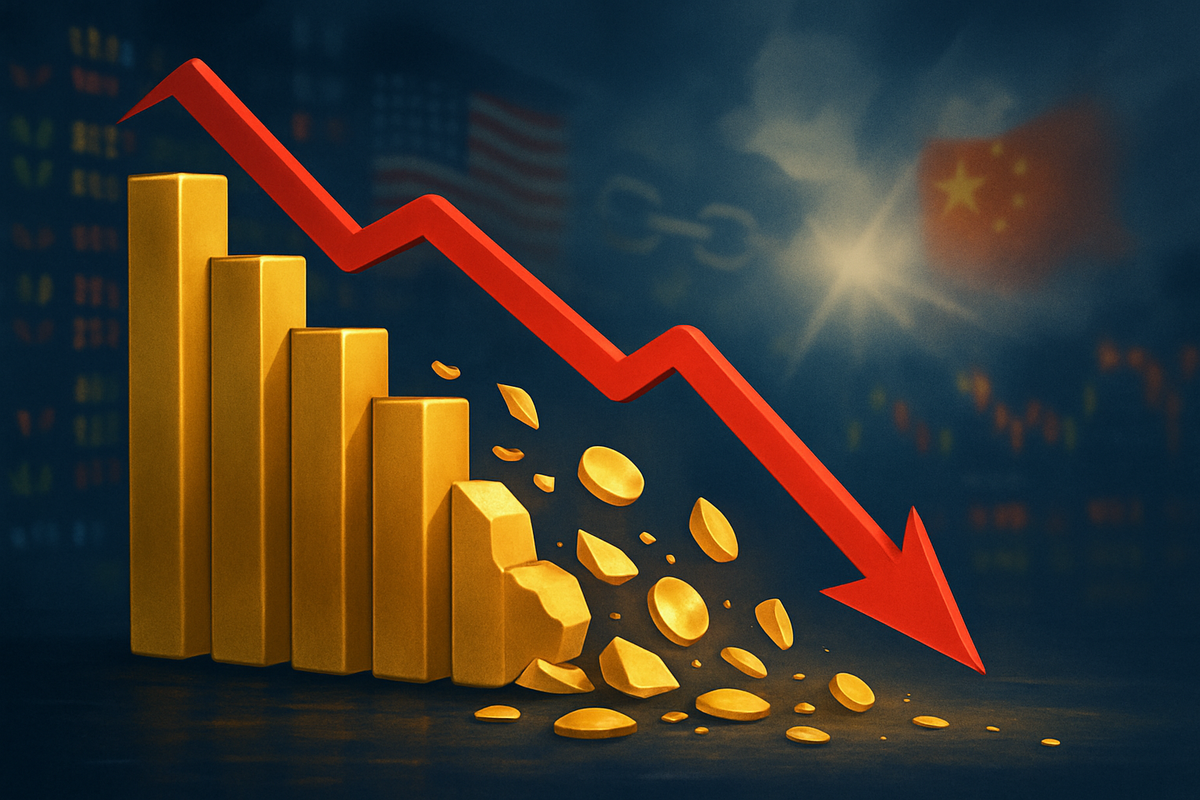
Gold, the traditional safe haven for investors, experienced a dramatic and sharp decline in October 2025, sending ripples of concern and opportunity through global financial markets. After an unprecedented rally that saw the precious metal shatter records, surpassing $4,000 per ounce and peaking at an astonishing $4,381 on October 21st, the market witnessed a swift and brutal selloff. This immediate reversal, characterized by widespread profit-taking and a significant shift in investor sentiment, marks a critical juncture for gold and those who invest in it, signaling a potential recalibration of risk appetite amidst evolving geopolitical and economic landscapes.
The Golden Flash Crash: Unpacking the Sudden Plunge
The decline in gold prices was both sudden and severe, occurring almost immediately after reaching its all-time high. On October 21, 2025, gold plummeted over 5% in a single trading session, marking its steepest daily fall in over five years, and by some accounts, over a decade. The selloff continued into October 22, with futures declining further, trading below $4,100 per ounce and approaching the psychological $4,000 level. In a mere 24 to 48 hours, gold shed approximately 7.5% to 9% of its value from its peak.
Several factors converged to trigger this dramatic downturn. Primarily, the market was ripe for widespread profit-taking. After such a historic and relentless rally, gold had become severely overbought from a technical perspective, prompting investors to lock in their substantial gains. This was exacerbated by a notable strengthening of the U.S. dollar index, which makes dollar-denominated assets like gold more expensive for international buyers, thereby reducing demand.
Crucially, a significant easing of trade tensions between the United States and China played a pivotal role in diminishing gold's safe-haven appeal. Reports of an impending meeting between U.S. President Donald Trump and Chinese President Xi Jinping, coupled with President Trump's optimistic statements regarding a "fair deal" and acknowledging the unsustainability of high tariffs, fostered a renewed sense of optimism for a resolution to ongoing trade disputes. This starkly contrasted with earlier in 2025, when the escalating trade war had been a primary driver of gold's upward trajectory. The broader financial markets reacted with a "better risk appetite," leading to a shift of funds towards equities and other higher-risk assets, further reducing the demand for traditional safe havens. While economic uncertainty, persistent inflation concerns, and geopolitical tensions had fueled gold's earlier rally, the October decline was largely a technical correction driven by profit-taking and a perceived reduction in immediate geopolitical risks, rather than a sudden fundamental shift in the broader economic outlook. Silver, often correlated with gold, experienced an even more amplified response, with drops ranging from 6.5% to 12%.
Navigating the Volatility: Winners and Losers in the Gold Market
The sharp decline in gold prices has immediate and significant implications for a range of market participants, creating both winners and losers. For gold mining companies, the immediate impact is largely negative. Companies like Barrick Gold Corporation (NYSE: GOLD), Newmont Corporation (NYSE: NEM), and Agnico Eagle Mines Limited (NYSE: AEM) will likely see their profit margins squeezed as the price of their primary product decreases. Lower gold prices can lead to reduced revenue, potentially impacting their exploration budgets, dividend policies, and overall stock valuations. Investors holding shares in these companies may experience a downturn in their portfolios.
Conversely, some entities could emerge as beneficiaries. For instance, jewelry retailers and industrial users of gold might see a reduction in their input costs, potentially boosting their own profit margins or allowing them to offer more competitive pricing. While not directly a "winner" in the sense of profiting from the decline, investors who had been waiting for a correction to enter the gold market, or those looking to average down their positions, might view this as a buying opportunity. Furthermore, investment vehicles that short gold or utilize inverse ETFs designed to profit from falling prices would have seen significant gains during this period.
The broader financial sector, particularly investment funds and hedge funds with significant exposure to commodities, will need to re-evaluate their gold holdings. Those who had taken substantial long positions in gold leading up to its peak would have faced considerable losses during the selloff, prompting a reassessment of their risk management strategies and asset allocation. Central banks, which have been significant buyers of gold in recent years, may also adjust their purchasing strategies, although their long-term strategic accumulation is typically less sensitive to short-term price fluctuations.
Broader Implications: A Shift in the Investment Landscape
This sudden gold selloff is more than just a momentary blip; it signals a potential shift in broader industry trends and investor psychology. For much of 2025, gold's ascent was fueled by a pervasive sense of global uncertainty – from escalating trade wars to persistent inflation fears and geopolitical instability. The recent easing of U.S.-China trade tensions, even if tentative, has served to deflate some of that uncertainty, prompting a rotation out of safe-haven assets and into riskier, growth-oriented investments. This indicates a renewed "risk-on" sentiment in the market, suggesting that investors are becoming more comfortable with economic prospects, or at least less fearful of immediate downturns.
The ripple effects could be significant. Competitors in the precious metals space, particularly silver, have already shown amplified responses to gold's decline, indicating a broader weakening across the sector. This event could also influence other safe-haven assets, such as certain government bonds, if the underlying drivers of risk aversion continue to recede. Regulatory or policy implications are less direct but could emerge if the volatility spills over into other markets, potentially prompting discussions around market circuit breakers or enhanced transparency in commodity trading. Historically, sharp corrections after significant rallies are common, serving as necessary technical adjustments. This event can be compared to similar rapid pullbacks seen after periods of intense speculation or when underlying market narratives shift, reminding investors that even seemingly unstoppable trends are subject to gravity.
What Comes Next: Navigating the Post-Correction Environment
In the short term, the gold market is likely to remain highly volatile as investors digest the recent price action and re-evaluate their positions. Further technical corrections are possible, especially if the perceived easing of trade tensions holds or if other positive economic indicators emerge. However, the underlying factors that supported gold's rally – such as lingering inflation concerns, potential future geopolitical flare-ups, and the sheer volume of global debt – have not entirely disappeared. This suggests that while the immediate safe-haven appeal has diminished, gold's role as a long-term store of value may still be relevant.
For investors, potential strategic pivots include reassessing their exposure to precious metals and considering diversification into other asset classes. Market opportunities may emerge for those with a long-term bullish view on gold, as lower prices could present attractive entry points. Conversely, challenges include managing increased volatility and the risk of further downside if the "risk-on" sentiment continues to dominate. Potential scenarios range from a continued consolidation phase, where gold trades in a narrower range, to a gradual recovery if new uncertainties arise, or even further declines if global economic stability firmly takes hold and central banks adopt more hawkish stances.
The End of an Era or a Healthy Correction?
The brutal selloff in gold prices in October 2025 serves as a potent reminder of the dynamic nature of financial markets and the importance of understanding the multifaceted drivers behind asset valuations. The key takeaway is that after an extraordinary rally, a significant correction was almost inevitable, particularly as the immediate catalysts for safe-haven demand, such as acute trade tensions, began to recede. While the immediate market moving forward will be characterized by increased caution and scrutiny, gold's fundamental role as a hedge against systemic risk and inflation is unlikely to be entirely diminished.
Investors should watch closely for further developments in global trade relations, particularly between the U.S. and China, as well as any shifts in central bank monetary policies and broader economic data. The strength of the U.S. dollar will also remain a critical factor. This event underscores that while gold can offer protection during times of uncertainty, it is not immune to market corrections and shifts in investor sentiment. The coming months will reveal whether this was merely a healthy, albeit sharp, technical adjustment, or the beginning of a more prolonged period of weakness for the precious metal.
This content is intended for informational purposes only and is not financial advice





